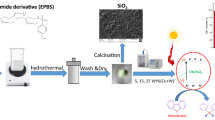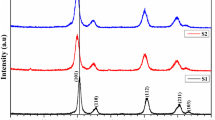Abstract
A sol–gel technique was useful for the synthesis of zirconia–silica nanoparticles. Metallic copper has decorated zirconia–silica nanoparticles via photo-assisted deposition method, decorated copper mass percent was varied from 0.5, 1.0, 1.5, and 2.0 wt%. XRD results confirm that decoration of zirconia–silica nanoparticles by copper did not alert XRD pattern of zirconia–silica nanoparticles and there are no peaks for copper or copper oxide, due to high dispersion of copper above a surface of zirconia–silica nanoparticles. The decoration of zirconia–silica nanoparticles by copper was reduced band gap energy of zirconia–silica nanoparticles from 3.20 to 2.35 eV with 1.5 wt% Cu decoration. Photocatalytic oxidation of thiophene in presence of visible light was selected to measure the impact of metallic copper on photocatalytic activity of zirconia–silica nanoparticles. 1.5 wt% Cu-decorated zirconia–silica nanoparticles can degrade 100% of thiophene within 90 min.











Similar content being viewed by others
References
Ashokkumar M, Muthukumaran S (2015) Effect of Ni doping on electrical, photoluminescence and magnetic behavior of Cu doped ZnO nanoparticles. J Lumin 162:97–103
Babikier M, Wang D, Wang J, Li Q, Sun J, Yan Y et al (2014) Cu-doped ZnO nanorod arrays: the effects of copper precursor and concentration. Nanoscale Res Lett 9:1–9
Bahsi ZB, Oral AY (2007) Effects of Mn and Cu doping on the microstructures and optical properties of sol–gel derived ZnO thin films. Opt Mater 29:672–678
Bish DL, Dreele RBV (1989) Rietveld refinement of non-hydrogen atomic positions in kaolinite. Clays Clay Miner 37:289–296
de Souza J, Rostirolla SP (2011) A fast MATLAB program to estimate the multifractal spectrum of multidimensional data: application to fractures. Comput Geosci 37:241–249
Guo MY, Ng AMC, Liu F, Djurisic AB, Chan WK, Su H, Wong KS (2011) Effect of native defects on photocatalytic properties of ZnO. J Phys Chem C 115:11095–11101
Herng T, Lau S, Yu S, Yang H, Wang L, Tanemura M et al (2007) Magnetic anisotropy in the ferromagnetic Cu-doped ZnO nano-needles. Appl Phys Lett 90:032509
Huang J, Dai Y, Gu C, Sun Y, Liu J (2013) Preparation of porous flower-like CuO/ZnO nanostructures and analysis of their gas-sensing property. J Alloy Comp 575:115–122
Kanade KG, Kale BB, Baeg JO, Lee SM, Lee CW, Moon SJ, Chang H (2007) Selfassembled aligned Cu doped ZnO nanoparticles for photocatalytic hydrogen production under visible light irradiation. J Mater Chem Phys 102:98–104
Kumar R, Umar A, Kumar G, Akhtar MS, Wang Y, Kim MS (2015) Ce-doped ZnO nanoparticles for efficient photocatalytic degradation of direct red-23 dye. Ceram Int 41(6):7773–7782
Marto J, São P, Marcos T, Trindade JA, Labrincha (2009) Photocatalytic decolouration of Orange II by ZnO active layers screen-printed on ceramic tiles. J Hazard Mater 163:36–42
Mecif A, Soro J, Harabi A, Bonnet JP (2010) Preparation of mullite- and zircon-based ceramics using kaolinite and zirconium oxide: a sintering study. J Am Ceram Soc 93(5):1306–1312
Mirashi NN, Chaudhury S, Aggarwal SK (2010) Dissolution of sintered thorium dioxide in phosphoric acid using autoclave and microwave methods with detection by gamma spectrometry. J Microchem 94:24–27
Pukird S, Song W, Noothongkaew S, Kim SK, Min BK, Kim SJ, Kim KW, Myung S, An KS (2015) Synthesis and electrical characterization of vertically-aligned ZnO–CuO hybrid nanowire p-n junctions. Appl Surf Sci 351:546–549
Rego E, Marto J, Marcos PS, Labrincha JA (2009) Decolouration of Orange II solutions by TiO2 and ZnO active layers screen-printed on ceramic tiles under sunlight irradiation. Appl Catal A Gen 355:109–114
Robak E, Coy E, Kotkowiak M, Jurga S, Załęski K, Drozdowski H (2016) The effect of Cu doping on the mechanical and optical properties of zinc oxide nanowires synthesized by hydrothermal route. Nanotechnology 27:175706
Sharma RK, Ghose R (2014) Synthesis of nanocrystalline CuO–ZnO mixed metal oxide powder by a homogeneous precipitation method. Ceram Int 40:10919–10926
Tan G, Zhang L, Ren H, Huang J, Yang W, Xia A (2014) Microwave hydrothermal synthesis of N-doped BiVO4 nanoplates with exposed (040) facets and enhanced visible-light photocatalytic properties. Ceram Int 40:9541–9547
Tian X, Pan Z, Zhang H, Fan H, Zeng X, Xiao C, Hu G, Wei Z (2013) Growth and characterization of the Al-doped and Al–Sn co-doped ZnO nanostructures. Ceram Int 39:6497–6502
Tsay CY, Wang MC (2013) Structural and optical studies on sol–gel derived ZnO thin films by excimer laser annealing. Ceram Int 39:469–474
Wu C (2014) Facile one-step synthesis of N-doped ZnO micro-polyhedrons for efficient photocatalytic degradation of formaldehyde under visible-light irradiation. Appl Surf Sci 319:237–243
Zaman S (2012) Synthesis of ZnO, CuO and their composite nanostructures for optoelectronics, sensing and catalytic applications. Thesis, Linköping University, Sweden
Zen S, El Berrichi FZ (2014) Adsorption of tannery anionic dyes by modified kaolin from aqueous solution. Desalin Water Treat 57(13):1–9
Zen S, Berrichi FZE, Maoui A (2014) Efficient anionic dyes adsorption on activated algerian clays. In: Dincer I, Midilli A, Kucuk H (eds) Progress in exergy, energy, and the environment. Springer, Cham
Author information
Authors and Affiliations
Corresponding author
Additional information
Publisher’s Note
Springer Nature remains neutral with regard to jurisdictional claims in published maps and institutional affiliations.
Rights and permissions
About this article
Cite this article
Basaleh, A.S., Mohamed, R.M. Photodegradation of thiophene over ZrO2–SiO2 nanoparticles: impact of copper decoration on their photocatalytic activity. Appl Nanosci 9, 2051–2058 (2019). https://doi.org/10.1007/s13204-019-00992-9
Received:
Accepted:
Published:
Issue Date:
DOI: https://doi.org/10.1007/s13204-019-00992-9




